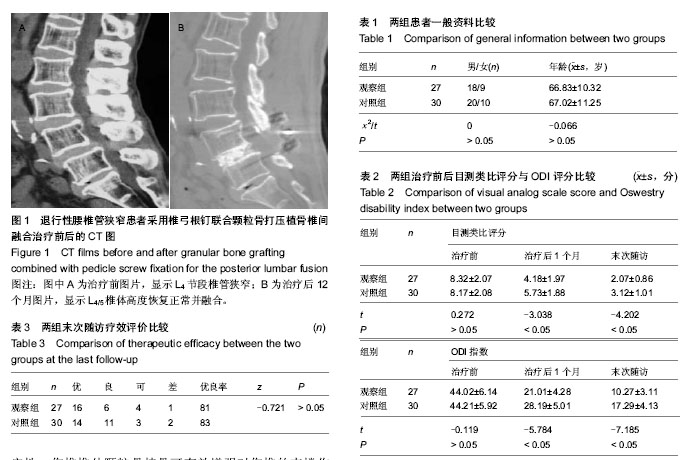| [1] 高志洋,刘海明,宋舟锋.不同椎问融合术治疗腰椎退变性疾病的疗效比较[J].浙江临床医学,2014,16(4):530-532.
[2] Willen J,Wessberg PJ,Danielsson B.Surgical results in hidden lumbar spinal Stenosisdetected by axial loaded computed tomography and magnetlc reseonnace imaging:anoutcome study.Spine.2008;33(11):109-115.
[3] Jssack PS, Cunningham ME, Pumberger M, et al. Degenerative lumbar spinal stenosis:evaluation and management.J Am Aead Orthop Surg.2012;20(8):527-535.
[4] Sivaraman A, Ahaf F, Jalgaonkar A, et al. Prospective study of posterior Lumbar interbody fusion with either interbody graft or interbody cage inthe treatment ofdegenerative spondylolisthesis. J Spinal Disord Tech.2013;23(7): 235-237.
[5] Boissiere L, Pen-in G, Rigal J, et al. Lumbar-sacral fusion by a combined approach using interbody PEEK cage and posterior pedicle-screw fixation:clinical and Radiologieal results from a prospective study. Orthep Traumatol Surg Res.2013;99(21): 945-951.
[6] 隋海涛,冯涛,李亮,等.经椎间孔椎间融合术联合Wiltse入路椎弓根固定治疗腰椎间盘突出症[J].中国矫形外科杂志,2013,21(15): 1519-1523.
[7] 魏富鑫,刘少喻,崔尚斌,等.后路单侧椎弓根钉固定联合椎间融合术治疗退行性腰椎失稳[J].中国修复重建外科杂志,2013,27(6): 703-707.
[8] 李传思,安辉.后路自体骨粒打压植骨椎间融合术治疗腰椎滑脱症[J].山东医药,2011,51(10):47-48.
[9] 匡凌浩,徐冬,李广庆,等.经椎间孔椎体间融合术治疗腰椎滑脱症的疗效观察[J].中华医学杂志,2014,94(29):2293-2296.
[10] 曾忠友,吴鹏,唐宏超,等.椎弓根螺钉联合椎板关节突螺钉固定治疗腰椎骨折[J].中华创伤骨科杂志,2014,16(3):212-217.
[11] 李罡,樊世峰.两种椎间植骨融合术治疗腰椎滑脱症的临床效果比较[J].重庆医学,2013,42(13):1526-1528.
[12] 谢松林,顾开宏,秦树连.三种植骨融合术治疗退变性腰椎滑脱症的疗效分析[J].中国骨与关节杂志,2012,11(3):221-224.
[13] 黄强,杨静,沈彬,等.大量同种异体颗粒骨打压植骨结合多孔非骨水泥臼杯翻修髋臼大面积骨缺损的中期疗效[J].中华关节外科杂志(电子版),2013,7(5):609-614.
[14] 刘志,王明明,杨锡明.应用打压植骨与大块植骨治疗塌陷型胫骨平台骨折的疗效分析[J].中华临床医师杂志(电子版),2013,7(4): 1549-1552.
[15] 席澍,张纯朴,张英泽,等.打压成形植骨治疗大段骨缺损的可行性研究[J].河北医科大学学报,2014,45(7):812-814.
[16] 万永杰.膨胀椎间融合器治疗腰椎不稳25例疗效观察[J].河南医学研究,2014,23(8):47-49.
[17] 张新胜,崔力扬,罗建平,等.Ponté截骨联合椎间隙颗粒骨打压植骨治疗陈旧性胸腰椎骨折后凸畸形[J].中华骨科杂志,2014, 34(5): 531-539.
[18] 王翀,方明桥,项光恒,等.单侧与双侧椎弓根螺钉固定联合经椎间孔椎间融合术治疗腰椎退行性疾病的长期疗效比较[J].中国脊柱脊髓杂志,2014,24(9):795-801.
[19] 蔡子军,吴培斌,熊含颖,等.微创通道减压联合经皮椎弓根螺钉内固定术在腰椎间盘突出症中的临床应用[J].实用医学杂志,2014, 30(16):2611-2613.
[20] 宋西正,王文军,薛静波,等.经皮椎弓根螺钉内固定联合骶前间隙轴向椎间融合治疗L5椎体滑脱症[J].中国脊柱脊髓杂志,2014, 24(5): 407-411.
[21] 郑勇,王建,袁超,等.微创经椎间孔腰椎间融合术治疗高位腰椎间盘突出症[J].中国修复重建外科杂志,2014,28(4):480-484.
[22] 沈晓龙,张海龙,顾昕,等.微创经椎间孔椎间融合术联合单侧与双侧内固定技术治疗腰椎退变性疾病的疗效比较[J].中国脊柱脊髓杂志,2014,24(4):344-349.
[23] 梁昌详,昌耘冰,詹世强,等.Coflex植入术与腰椎椎间融合术治疗L4/5腰椎退变性疾病的临床疗效对比[J].中国临床解剖学杂志, 2014,98(1):32-35.
[24] 史君,胡力,周忠,等.单双侧椎弓根钉内固定结合椎间融合术治疗腰椎退行性疾病的疗效比较[J].中国矫形外科杂志,2013,21(7): 651-657.
[25] 杨进,孔清泉,宋跃明,等.微创小切口与开放经椎间孔腰椎椎间融合术治疗单节段腰椎退变疾患的近期疗效比较[J].中国修复重建外科杂志,2013,27(3):262-267.
[26] 李向明,张玉松,侯致典,等.轴向腰椎椎间融合术入路的应用解剖[J].中国临床解剖学杂志,2011,29(1):34-38.
[27] 侯秀伟,吴广良,杨贺军,等.腰椎管狭窄症减压内固定椎间融合术的近期并发症(附195例分析)[J].中国矫形外科杂志,2012, 20(11):1053-1054.
[28] 王翀,方明桥,项光恒,等.单侧与双侧椎弓根螺钉固定联合经椎间孔椎间融合术治疗腰椎退行性疾病的长期疗效比较[J].中国脊柱脊髓杂志,2014,24(9):795-801.
[29] 徐灿华,吴增晖,郑轶,等.腰椎极外侧入路椎间融合术在腰椎融合术后邻近节段病变中的初步应用[J].第三军医大学学报,2014, 37(17):1837-1841.
[30] 张健,梁卫东,盛伟斌,等.经后外侧入路椎间盘摘除椎间融合术治疗胸椎间盘突出症[J].中国脊柱脊髓杂志,2014,24(2):116-120. |
